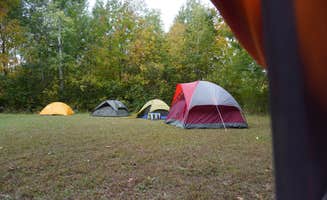Tent camping near Horicon, Wisconsin provides opportunities to explore the glacially-formed landscapes of east-central Wisconsin. Campsites in this region range from 750 to 1,100 feet in elevation, with the area receiving approximately 35 inches of precipitation annually. Summer temperatures typically range from 60°F to 85°F, making late spring through early fall the prime camping season in the region.
What to do
Wildlife viewing opportunities: Horicon Marsh, the largest freshwater cattail marsh in the United States, attracts numerous bird species. Nearby at Snug Harbor Inn Campground on Turtle Lake, campers have lakefront access. "They also have tent sites. This season there will be new owners so I hope they keep some of the annual activities," notes Kevin C.
Backpacking trails: The area offers hiking opportunities with backpacking sites at KMSF Shelter 1 Backpack Site. "Great backpack camp site. Decent walk and terrain to get to the site. There is an open shelter to put your tent if you prefer to outside," states Erin Z. The shelter includes a fire pit and picnic table for overnight stays.
Cycling routes: The Glacial Drumlin bike trail connects to several camping areas in the region. According to Kim L., "Wild Goose bike trail leads to this park in Juneau. It's a good place to stop and have a break. There's a playground and public bathroom, drinking fountain."
What campers like
Private campsites: Many campers appreciate the secluded nature of sites in the Horicon area. Hilary S. from Northern Unit Greenbush Group Camp reports, "The nine sites are visually separated, but not far enough away from each other to block louder noise. We had six tents, but the site could easily have accommodated more."
Lake views: Waterfront camping provides scenic vistas at several locations. At Snug Harbor, Josh F. notes, "The property is basically terraced along a slope down to the lake, with the RV and mobile home sites closer to the lake. The tent sites are above it all with decent views of the lake below."
Oak savanna environments: The region's natural landscape features oak savannas ideal for tent camping. Tawnie T. from Sandhill Station State Campground shares, "The sites are all very remote; no onsite rangers or anything like that. Beautiful walk in sites, no carts to haul gear so pack light!"
What you should know
Weather considerations: The region can experience extreme temperature variations. Tawnie T. warns about Sandhill Station: "We were there in mid-June on one of the hottest weekends of the year and we were massacred the second we walked into the site. I do believe these would be lovely sites in the fall or Spring, though."
Gear hauling requirements: Many campsites require carrying equipment from parking areas. At KMSF Shelter 1, campers should "Bring a small axe" for gathering firewood, as Erin Z. recommends, noting the site has limited facilities but "It's very secluded for privacy."
Water availability: Access to drinking water varies significantly between campgrounds. Hilary S. observed at Northern Unit Greenbush: "Water is usually available, but more limited during the pandemic (spigot turned off by our campsite, but available near the parking lot at the entrance - a longer walk)."
Tips for camping with families
Playground accessibility: Several campgrounds offer playgrounds for children. At Wild Goose City Park, Kim L. mentions, "There's a playground and public bathroom, drinking fountain. Plenty of space to spread out for a picnic when you're biking through."
Group camping options: Families can book adjacent sites or group areas. Amber R. describes Greenbush Group Campground: "Large sites great for groups. Sites 2 and 9 are the largest. Those can each fit over 20 backpacking tents at the same time. Grassy sites surrounded by trees (plenty for hammocks too)."
Small campground advantages: Less crowded options provide quieter family experiences. Kevin S. describes Waubedonia County Park as "A nice little campground near the river in Fredonia, WI. The campsites are inexpensive and comfortable, though there aren't as many amenities that a larger campground would have."
Tips from RVers
Terrain awareness: The sloped landscape affects site selection. Josh F. notes about Snug Harbor, "The campground is basically terraced along a slope down to the lake, with the RV and mobile home sites closer to the lake."
On-site amenities: Some campgrounds provide additional services. James W. shares his experience at Snug Harbor: "Staff was great, helped me back in. Nice Bar/Restaurant on site. Met 2 nice couples which helped with any questions."
Seasonal considerations: Weather patterns impact the camping experience. Carole X. reported about her stay at Snug Harbor, "Beautiful views overlooking Turtle Lake. Friendly and helpful staff. My husband got stung twice when we went to plug-in our electric. But the staff came out immediately to spray and remove the nest."



